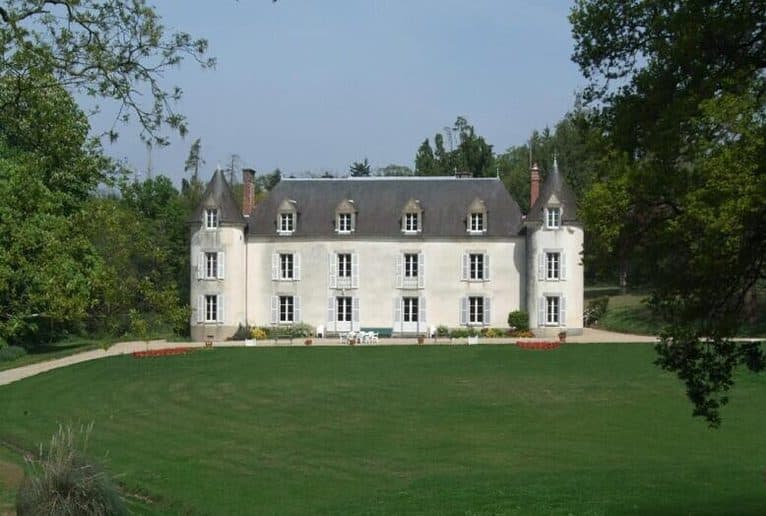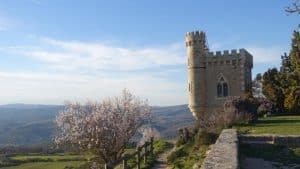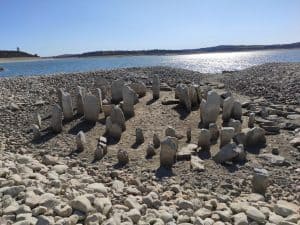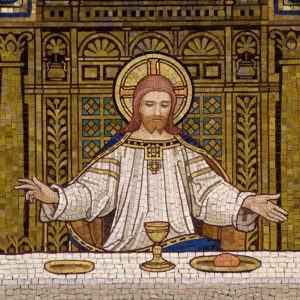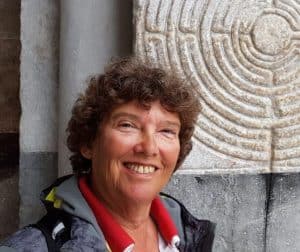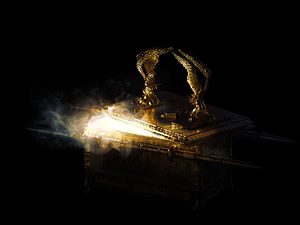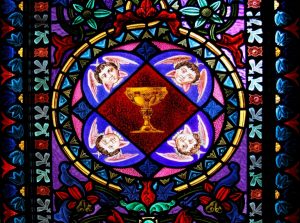Near the town of Tréhorenteuc you will find the forest of Paimont. According to local legends, this is the forest Brocéliande, where King Arthur’s mysterious half-sister, Morgana, held her false lovers captive.
If you visit the magical forest of Brocéliande, don’t forget the mysterious church in Trehorenteuc! It is one of the most enigmatic grail churches I have ever visited in France!
In the late 12th century, Chrétien de Troyes concocted the legend of the Brocéliande woodland.
“The Forest of Wonders” was written in his Arthurian novel “The Knight with the Lion.” He was inspired by “Bréchéliant,” a forest in Little Brittany that is full of folklore and other fantastic stories. To this day, the Forest of Paimpont preserves the history of this fabled forest.
Visit Brocéliande, and you’ll get a taste of the mythical woodland of tales as well as the true, somewhat obscure, atmosphere that makes this forest unique.
Supernatural: La fontaine de Barenton
The Barenton Fountain has been known for hundreds of years to have supernatural powers. It is hidden in the Brocéliande forest near the village of Folles Pensées.
The first time the Barenton fountain is mentioned in writing is in the 12th century. It is the only place in the Paimpont forest that really has something to do with the legend of King Arthur. Tobert Wace went there in the 12th century. He was a poet who wanted to see for himself how amazing the fountain was.
The fountain can help people feel better, but it can also cause big disasters. A storm starts when water is poured onto the stone slab next to it. Chrétien de Troyes told this story in “Le Chevalier de Lion,” and the church of Tréhorenteuc has a painting of it.
For a long time, people used to come here during times of drought. Parishioners would ask Saint Mathurin for rain by dipping the foot of a Cross in the water.

The grave of Merlin
Mr. Poignand, a judge at the Tribunal de Montfort at the start of the 19th century, was sure of it. In a pamphlet from 1820, he said Merlin, King Arthur’s advisor, was buried at the end of the 5th century in the forest of Brocéliande, near Saint-Malon-on-Mel, in a place called Les Landelles.
In 1889, the French writer Félix Bellamy researched the place Poignand had called “Merlin’s Tomb” 70 years earlier. He found a megalithic monument of which only 6 blocks were still standing. When he returned in October 1892, the cemetery had been blown up and destroyed by treasure hunters. There are only two large stones left today.
The Tomb of Merlin is in the direction of Saint-Malon-sur-Mel in the national forest of Paimpont. Close to the road, the site is set up with paths and informational signs. There is a parking lot nearby.

The fountain of youth
This small fountain is close to Merlin’s tomb. It is said that in the past, it was surrounded by very large stones and looked very impressive. It seems that druids used this place as a place to worship. Each year, during the summer solstice, druids were said to have taken newborn children to the fountain and recorded their names on a register known as the marith. In the Celtic language, these water sources were called “Jaouanc,” which means “youth.”
Parents who couldn’t bring their child in the year of his or her birth could register him or her the next year. The child was then considered a new-born and was therefore a year younger!
The valley of no return
The Val sans Retour, or the Valley of No Return, is where Morgana, King Arthur’s sister, would make unfaithful lovers her prisoner. They would be stuck there forever.
Lancelot came to free one of them and won the battle against Morgana who then released all the cursed lovers. But Lancelot paid a high price because Morgana managed to capture him. Despite her many lovers, Morgana had always been in love with Lancelot. But he only had eyes for Guinevere, the wife of King Arthur. This was one of the reasons Morgana became evil. Eventually, Lancelot managed to escape and continued his journey to find the Grail.
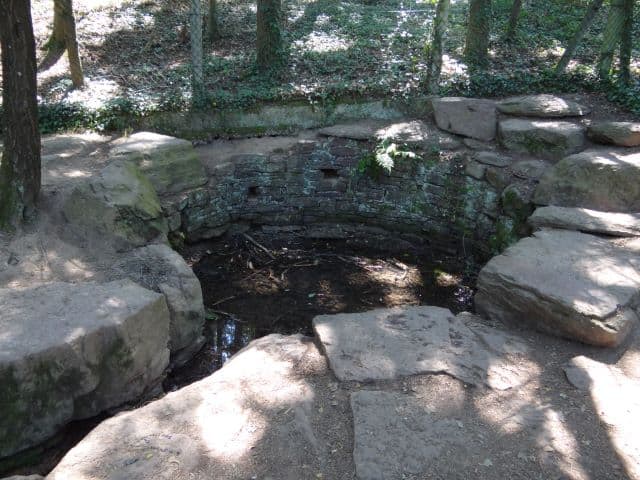
The fairy mirror
The crystal clear water of the pond at the entrance to the Val of No Return suggests the presence of magic. People say that seven fairies once lived in this pond. One day, out of curiosity, one of them went to look at a man and they fell in love with each other. When the sisters saw what was going on, they killed the man because they couldn’t stand seeing the two together like that. Stricken with grief, the young fairy killed her sisters.
Now the water is so calm that you can see your own face in it.

The golden tree
The Tree of Gold, designed by François Davin in 1991 and located in the bottom section of the Valley of No Return, in the village of Paimpont, is a work of art. A terrible fire destroyed about 400 hectares of forest in 1990. This tree, which is clothed with actual gold leaf, signifies the forest’s rebirth, as well as its fragile and valuable character. It is encircled by five charred trees that represent the vanishing of nature.
The seat of Merlin

A unique formation, nicknamed the “Seat of Merlin,” can be found on the crest of the Val sans Retour. At the top of the Val sans Retour, there is a unique formation known as the “Seat of Merlin.” It is made of tilted, dark slate with numerous cracks. From there, the view spans the entire western horizon. Merlin is said to have preferred to spend his nights there, reflecting on the events of the day and planning the events of tomorrow.
The site is depicted in the church of Tréhorenteuc. I am not entirely sure if the abbé had the seat of Merlin in mind when he had these stones painted. Maybe they refer to the petrified lovers who tried to escape Morgana’s spell.
The magical oak tree of the Hindrés

The Oak of the Hindrés is one of the largest of its kind in the Paimpont state forest, distinguished by its size and tortuous-shaped branches. A “humid location” is referred to as “Hindrés.” It is a sessile oak (Quercus Petraea) that has been designated as a notable tree since 1997. The Oak of the Hindrés, roughly 500 years old, will astonish you. Its massive straight trunk and beautiful weaving branches are a remarkable sight.
Chêne de rues Éon
The enormous circumference (10 meters!) and massive branches will undoubtedly amaze you. This huge tree in Concoret was formerly known as Chêne des rues Éon, in memory of Éon de l’Étoile.
Father Guillotin, a dissident priest who sought refuge in the hollow of his trunk during the French Revolution, gave the tree its name.
Éon de l’Étoile can be compared to Robin Hood. In the 12th century he roamed Brocéliande with his comrades. They robbed the rich to distribute the money to the poor.
The tree is between 800 and 1,000 years old.
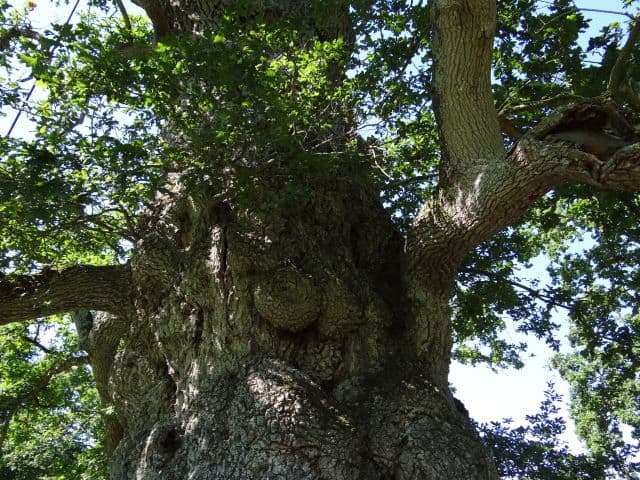
A map of Brocéliande
All places of interest you will find on a map, you can obtain at the tourist information. You can also download a map here. In our one-day visit to the forest en Tréhorenteuc we were not able to see everything. Therefore, it is a good idea to plan ahead and visit the things you would really like to see.
Practical information
You can spend more than one day in Broceliande and its vicinity, exploring the church and the Grail forest, Brocéliande. If you would like to stay in a hotel, You can use the app below. Just fill in the dates to see what facilities are available at that time. If it is still free, consider staying in Chateau de Ville Hué, about a half-hour drive from Trehorenteuc. It is not only a treat to stay at the castle, but the owner can tell you everything about the area.


